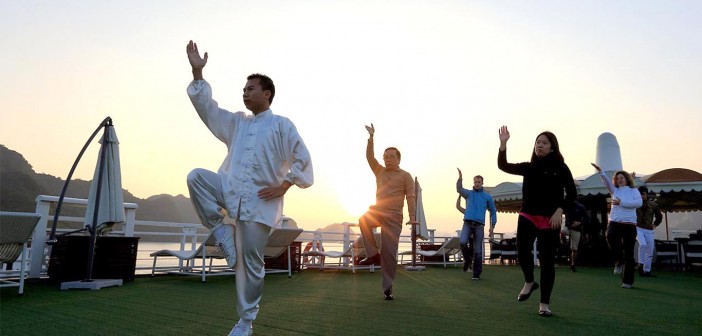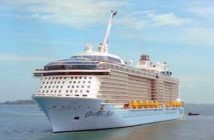China’s love of cruising is growing, but to entice travellers cruise lines must adapt, writes Lucy Jones.
They came. They saw. And now they are conquering.
Between 2012 and 2014, the number of Chinese cruisers grew by 79 per cent. In 2016 there will be more than one million cruise passengers from China – and by 2030 there are predictions for seven million. China has the potential to become the largest cruise market in the world – and the industry is taking notice.
International lines are now building billion-dollar ships that are specifically built for China’s new breed of cruise passenger.
But what does it actually mean to tailor a ship specifically for the Chinese market?
It’s a delicate balance for lines to maintain their unique characteristics while offering a product that appeals to local cruisers. Translating signage and hiring Mandarin-speaking crews, are basic changes. It’s the finer points that are still a work in progress.
China expert Christopher Beam from Bloomberg believes lines must rethink the whole cruise experience, from food to décor to the way in which a rapidly capitalising society thinks about class and luxury.
He says many Chinese cruisers dislike the democratisation of luxury that seems inherent in cruising. Those that had paid for the most expensive packages felt that they weren’t receiving enough special treatment. They want to be treated very differently to people who have paid less.
So what are cruise lines building into the fleet now targeting China?
SHOPPING
For a start, cruise lines have acknowledged shopping as a crucial lure.
Once onboard, there are immediate opportunities to spend. Duty free shopping is one of the main drawcards on international ships. With import taxes of up to 40 per cent on luxury goods in China, passengers are eager to purchase discount perfume, electrical goods and designer labels.
All ships sailing in China expand their shopping areas, often sacrificing entertainment space like a bar, theatre or cinema. Ports and shore excursions are often tailored around shopping too, taking passengers to huge electronics stores or pharmacies to stock up on items not available in China.
GAMBLING
There’s more spending at the casinos. Huge gaming floors are in operation almost continuously, with slot machines and tables for poker and blackjack, as well as popular Asian games like baccarat or sic bo. There are roped off areas for the real high rollers, betting far more than they have spent on their cruise fare.
FOOD
The most obvious change is the food. Ships replace whole restaurants with new Asian cuisines or adapt the buffet to feature local offerings, like congee for breakfast, bubble tea and noodle bars. Chinese eat earlier and faster, meaning the kitchens have to move a lot faster. Most lines do keep western options on the menu, reasoning that many Chinese travel to experience something new.
ACTIVITIES
Asian ships offer tai chi at dawn, line dancing classes in the afternoon and kung fu movies at midnight. The average Chinese cruiser is not looking to lie by the pool or read a book. One ship based in Shanghai even removed its spa because no one had time to use it.
Mainlanders are not big drinkers either. Bars and clubs on these ships are frequently empty, as opposed to sailings in Europe or the Caribbean where they will be packed until 4am. They do like to smoke, however, and many will ignore onboard bans.
THE PLAYERS
Costa Cruises was the first international line to enter the Chinese market, in 2006. It now has four vessels sailing in Asia following the arrival of Costa Fortuna in April this year.
Costa recently announced that Costa neoRomantica will also be based in Asia year-round from 2017. Though the line brands itself as “Italy at Sea”, all ships have been adapted for local cruisers.
In addition, the Costa Group recently announced an order for two new ships for Costa Asia, designed specifically for the Chinese market and built by the Fincantieri shipyard in Italy, to be launched in 2019 and 2020.
In 2014 Royal Caribbean made the unprecedented move of announcing it would homeport its latest and greatest ship, Quantum of the Seas, in China after just one season in the Caribbean. Two years later, sister ship Ovation of the Seas is also heading east, to be based in Tianjin. In 2016 five Royal Caribbean ships will be homeported in China.
Princess Cruises moved Sapphire Princess to Shanghai in 2014 and recently announced a new ship,Majestic Princess, to be built specifically for the Chinese market.
MSC Cruises brought its first ship to China in May, homeporting MSC Lirica in Shanghai. Carnival is moving two ships, Carnival Miracle and Carnival Splendor, from the US to China in 2017 and 2018.
Norwegian Cruise Line will launch its first purpose-built ship for the Chinese market in mid-2017. CalledNorwegian Joy it will also have a Chinese name, 喜悦号 (Xǐ Yuè Hào). As well as a huge shopping complex the ship will have a two-level go kart race track, hovercraft bumper cars and high speed waterslides.
In July 2015 SkySea Golden Era set sail, the first ship for the new SkySea Cruises line. It’s the first joint venture between a mainstream cruise line, Royal Caribbean, and a Chinese agency.
The ship previously sailed for Celebrity Cruises as Celebrity Century and is now almost unrecogniseable inside. Additions included two new restaurants (one Chinese and one Asian fusion), a karaoke room, mini golf course, a pharmacy and VIP cabanas by the pool.








